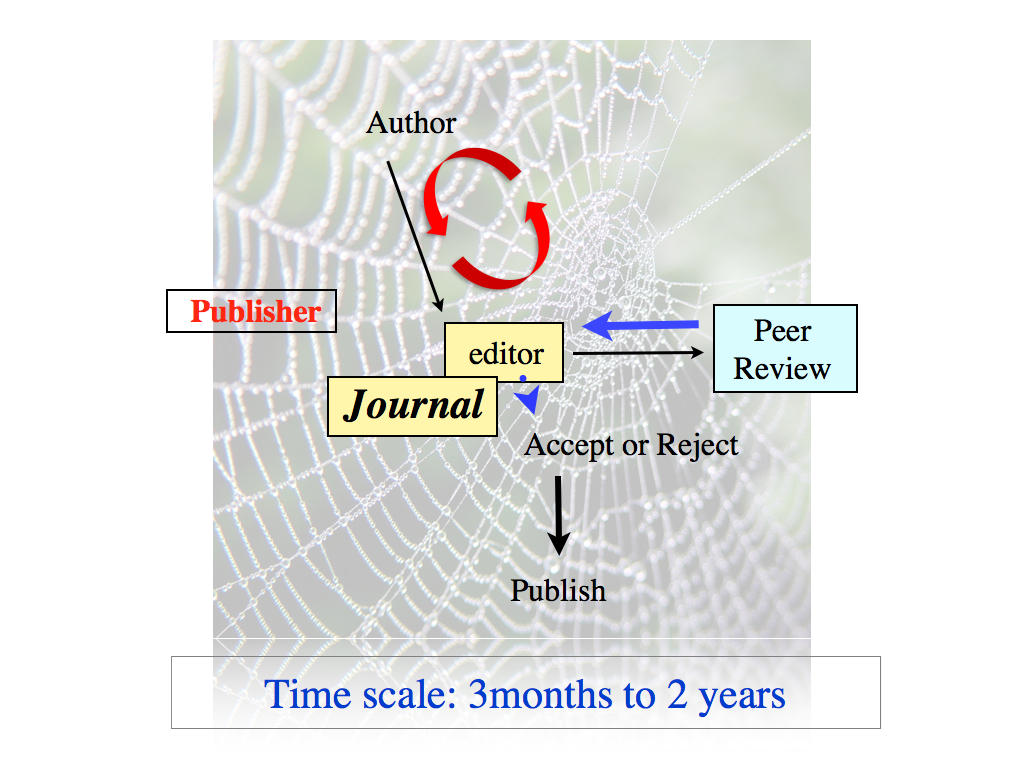These are notes for a lecture given by AMA in a workshop about Responsible Research held at LMU in Munich (Germany) on 24 July 2014 (www.responsibleresearch.graduatecenter.uni-muenchen.de/index.html). The lecture is broken into two parts, this one deals with biomedical publishing, its origins and current state. A second instalment on solutions will follow. Videos of both the lecture and the subsequent panel discussion are available at www.responsibleresearch.graduatecenter.uni-muenchen.de/presentations/videos/index.phpÂ
The answers to the title of this talk should be obvious. You want to publish your work in the most appropriate journal/place so that people know what you have done, use it in their research and ponder the consequences. As we shall see, like much of the biomedical sciences (and it is this that I shall refer to when talking about publishing), the answers are less straightforward and you should think about every one of them. None of this was a consideration for F Miescher when he discovered nuclein (later known as DNA) and in 1869 wrote a paper which he submitted to the journal of his boss Hoppe Seyler, the Hoppe Seyler Zeitshrift fur Physiologische Chemie. Hoppe Seyler found the finding of P and N in an organic material so remarkable that he refused to publish it until he had observed this himself; now this is proper peer review. Two years later, satisfied with his own experiments, he published the paper –and one of his on the subject to support the observation. Much to ponder here –notice that he did not scoop his pupil- but I will leave you to think about it. The delay, the publication, the interactions with Hoppe Seyler did not have much of an impact on the career of Miescher.
How much things have changed! Today biomedical sciences publishing is, like many other aspects of the field itself, in turmoil; subject to debate not just in the scientific arena but also in magazines and papers. The Economist and the Wall Street Journal, not to mention the New York Times and The Guardian, periodically raise issues about scientific reports, in particular the biomedical sciences. The reasons for this media attention are complicated and you have heard about and discussed some of them earlier in the day but essentially boil down to a complicated tangle that has emerged between publications, jobs and money. Matters like peer review, the process whereby a scientific report is judged to be suitable for publication, have become under scrutiny and perhaps it is not surprising that last year one can find over 1500 and rising peer reviewed (notice the irony) publications on peer review in PubMed (where there were less than 500 ten years ago), with many thousands more in blogs and comments in journals. Why? The main reason is that, as we all know, a publication today is not so much about reporting progress on experiments and findings but about jobs, about grants, about careers, about upmanship. Publications have become, without us realizing it, the token whereby we are judged and ranked. There is a rather poisonous knot here that I shall try to untangle in the second part of the talk. First, let us get some perspective on peer review, the axis of modern science reporting.
It surprises me that we use papers like the famed Watson and Crick manuscript on the structure of DNA in Nature (by the way there were two other papers in that issue, one by a Rosalind Franklin) as a reference of something wonderful which, if possible, should be imitated. That paper would not have passed the editors desk nowadays and the famed sentence at the end: ‘it has not escaped our notice…..†would only have served as a ticket for the editorial rejection paraphrased as “it has not escaped our notice that while this is an interesting speculation, it would be important to get some experimental results to support itâ€. Sure, the topic was hot but, under today’s editors, the paper was a speculation on somebody else’s data and should be published, if at all, in the hypothesis section. Whereas in the 1950s science publishing was a small business catering for a small science community, today science is a very large enterprise and, I would say, publishing has not kept pace in the right manner. The fact is that today, the whole publishing business is a tangled web that results from growth without design. What do I mean by this? How did we get here?
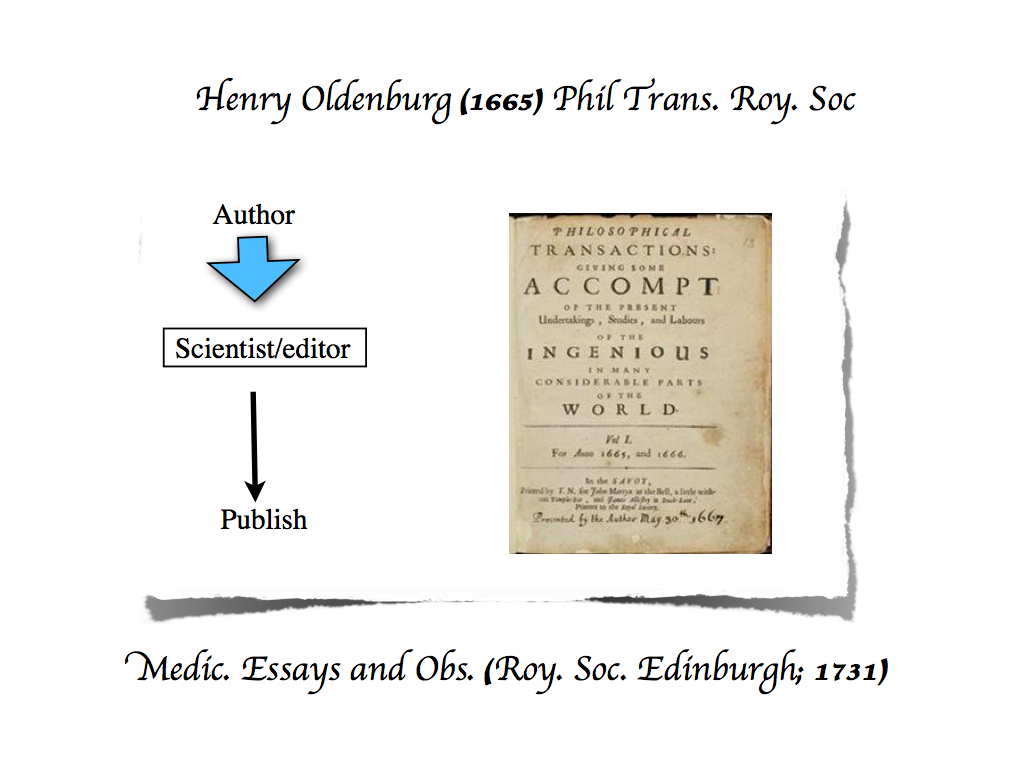 There has always been some control over what people wanted to publish, and before the Renaissance, and also afterwards, the catholic church had that power. After all this is what Copernicus and, most famously, Galileo had to endure if their papers, books at that time, were not to the liking of the church. Copernicus was most careful but Galileo was obliged to recant his beliefs in public under the threat of torture; a rather stern form of rejection. Think about it, today your paper is not published, in those days if the reviewers did not like the paper you could lose your life. There is some progress!.
There has always been some control over what people wanted to publish, and before the Renaissance, and also afterwards, the catholic church had that power. After all this is what Copernicus and, most famously, Galileo had to endure if their papers, books at that time, were not to the liking of the church. Copernicus was most careful but Galileo was obliged to recant his beliefs in public under the threat of torture; a rather stern form of rejection. Think about it, today your paper is not published, in those days if the reviewers did not like the paper you could lose your life. There is some progress!.
In more enlightened countries where the catholic church was not such an obstacle, Science (Natural Philosophy as it was called) was flourishing and some learned societies emerged to cater for this. Amidst these, the Royal Society of London. More of a gentleman’s club in the beginning than a society, it was a place in which people with a Science inclination got together to discuss what they were finding. People got into the habit of writing up reports and the Royal Society produced a repository for those reports: Philosophical Transactions of the Royal Society (1665) which is still being published today. Nothing new here, as at the time there were many different places where people could publish their observations and disquisitions e.g Acta eroditorum and Miscellanea curiosa. The Philosophical Transactions was another one but one which attracted the best in Europe. For example, it was here where Leeuwenhoek published his letters on what he saw down his lenses. The procedure was simple: you submitted a report, a scientist had a look at it and put it to print to be read by the people who were interested. It was here that, as the number of reports increased, the first hint of peer review appeared in the form of people, associated with the editor, who had a say on what had been submitted; basically making sure that it was not silly. But peer review in the sense of an external person to the journal checking the work was first used by the Medical Essays and Observations of the Royal Society of Edinburgh (1731). This kind of light touch review, mainly through the editor or someone very close to the editor of the journal, was adopted by the modern Science journals in the XIX century and this is the way in which Miescher and Mendel published their works. Another way to publish was books and this is, of course, how Darwin published his great work. No, his book was not peer reviewed though he did have what today we would call postpublication peer review. And a lot of it. Can you imagine what would have happened if Darwin would have had to subject himself to word limit, supplementary material and, above all, peer review?
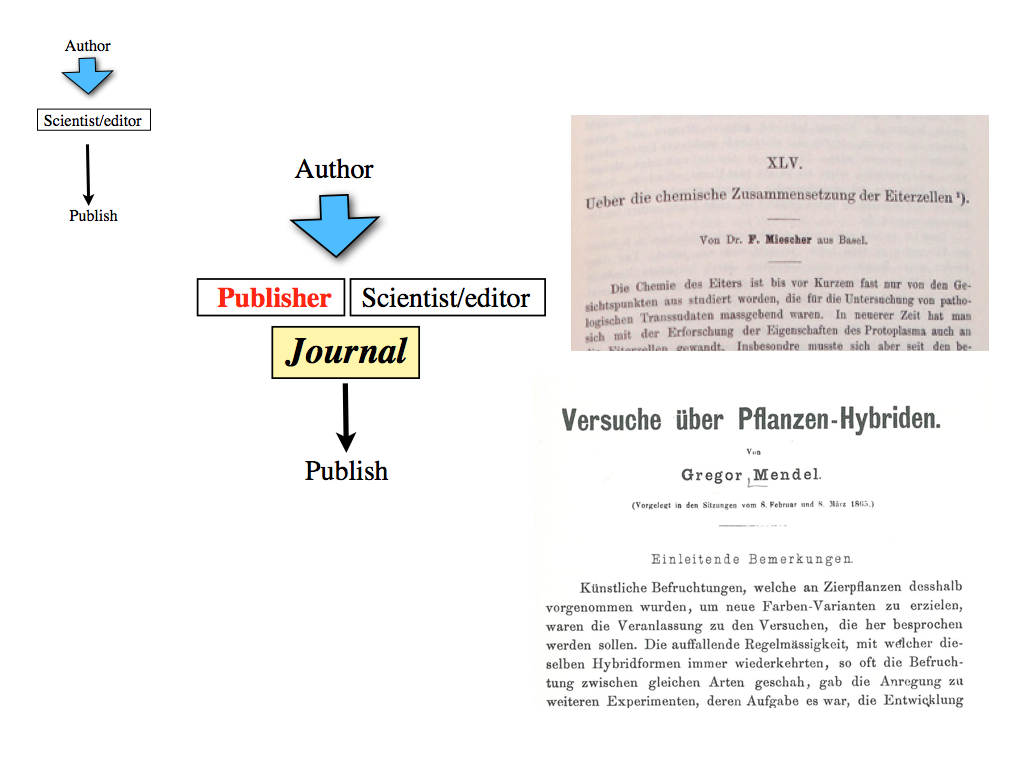 And so, by the turn of the XX century the industry had not changed that much and the small enterprise that was science put out their findings in small journals, run by editors with an interest in science. Nature had been born in 1869 and the Elzevir family began publishing books in the XVI century becoming Elsevier (home to The Lancet and Cell) in 1880 and Science was founded in 1880. The bunching around the late XIX century is not a coincidence, it is a reflection of the rise of journalism and, within this, of the interest to get science to the public. The function of those journals was not to be the arbiters of a scientists career, as it has become today, but to get the scientific advances to the people. This is what hides behind that emptiest of lines in a rejection letter from Nature or Science: “your work is not of sufficient general interest….â€. A vestige of a past in which, unlike now, such journals did sell to the people. In any case, in those days scientists had more specialized forums for discussions amidst themselves. It will not be a surprise to you that the mechanics of a scientific publication was different in those days.
And so, by the turn of the XX century the industry had not changed that much and the small enterprise that was science put out their findings in small journals, run by editors with an interest in science. Nature had been born in 1869 and the Elzevir family began publishing books in the XVI century becoming Elsevier (home to The Lancet and Cell) in 1880 and Science was founded in 1880. The bunching around the late XIX century is not a coincidence, it is a reflection of the rise of journalism and, within this, of the interest to get science to the public. The function of those journals was not to be the arbiters of a scientists career, as it has become today, but to get the scientific advances to the people. This is what hides behind that emptiest of lines in a rejection letter from Nature or Science: “your work is not of sufficient general interest….â€. A vestige of a past in which, unlike now, such journals did sell to the people. In any case, in those days scientists had more specialized forums for discussions amidst themselves. It will not be a surprise to you that the mechanics of a scientific publication was different in those days.
Over the last few months, in the tangled discussions of Peer Review and as an act of rebellion, a famous incident involving Einstein is often quoted in the context of the negative effects of peer review (for a proper account of the event see Sean Carroll www.preposterousuniverse.com/blog/2005/09/16/einstein-vs-physical-review ). Einstein had submitted a paper to Physical Review on gravitational waves and the editor took the then unusual step, of asking for one referee report as he thought, rightly it would appear now, that there might be a problem with the work. When he sent the comments to Einstein for correction, Einsten’s reply was harsh:
“We (Mr. Rosen and I) had sent you our manuscript for publication and had not authorized you to show it to specialists before it is printed. I see no reason to address the â€in any case erroneous†comments of your anonymous expert. On the basis of this incident I prefer to publish the paper elsewhereâ€
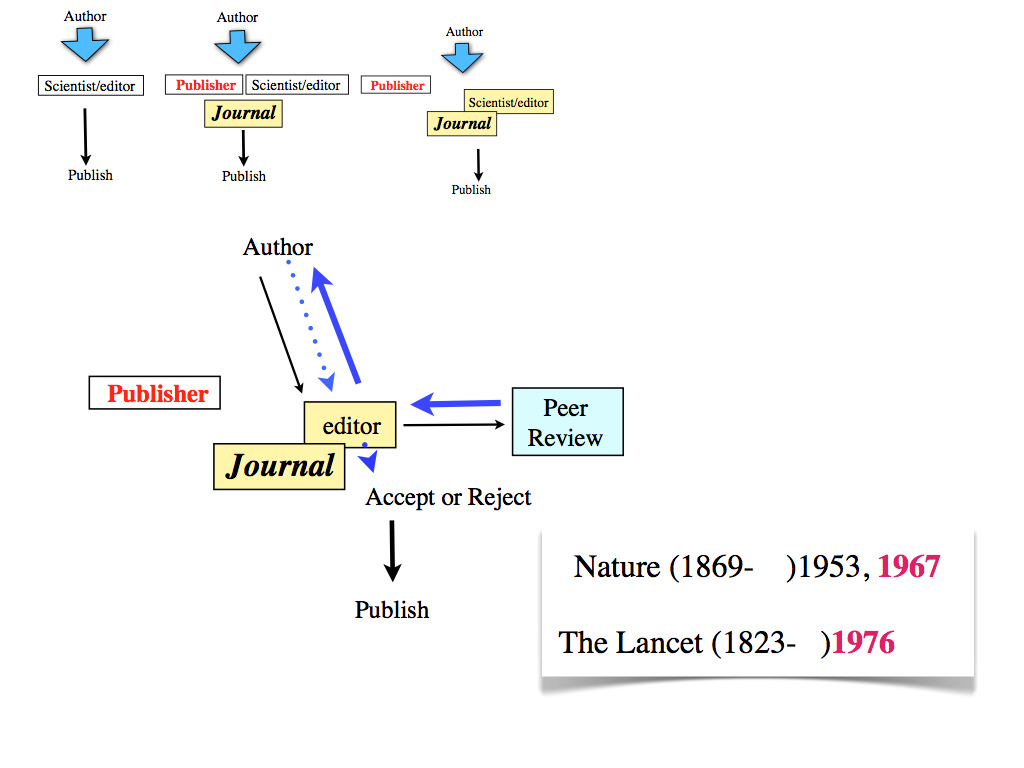 And this he did. The point of the story is not the one people often quote it for. The point is that Einstein was right at being surprised to have the paper reviewed, because in those days, papers were not reviewed; certainly not in the manner that we do and understand today. Editors needed papers, often commissioned papers, and while they might make editorial comments, they certainly did not share the papers with anybody else. This type of review applied to the Watson and Crick paper and to the plethora of papers that form the basis of molecular and cell biology. However, as the number of scientists and papers increased and the material for publication began to accumulate, together with specialization, we start to see something more like the peer review process of today. Nature introduced a version of it in 1953 and implemented the seeds of what we have today in 1967. But The Lancet only introduced it in 1976! And with this small step, of a fair system to control the quality of what is published a complex machine is set in motion that today is a very complicated business, which can keep your paper going around in circles for up to two years in the high end of the market….the notion of high end of the market is, also a new development….basically, all has gone pear shaped. For a nice account of the life span of an average paper see S. Royle’s blog “some things last a long time†(https://quantixed.wordpress.com/2014/04/15/some-things-last-a-long-time/)
And this he did. The point of the story is not the one people often quote it for. The point is that Einstein was right at being surprised to have the paper reviewed, because in those days, papers were not reviewed; certainly not in the manner that we do and understand today. Editors needed papers, often commissioned papers, and while they might make editorial comments, they certainly did not share the papers with anybody else. This type of review applied to the Watson and Crick paper and to the plethora of papers that form the basis of molecular and cell biology. However, as the number of scientists and papers increased and the material for publication began to accumulate, together with specialization, we start to see something more like the peer review process of today. Nature introduced a version of it in 1953 and implemented the seeds of what we have today in 1967. But The Lancet only introduced it in 1976! And with this small step, of a fair system to control the quality of what is published a complex machine is set in motion that today is a very complicated business, which can keep your paper going around in circles for up to two years in the high end of the market….the notion of high end of the market is, also a new development….basically, all has gone pear shaped. For a nice account of the life span of an average paper see S. Royle’s blog “some things last a long time†(https://quantixed.wordpress.com/2014/04/15/some-things-last-a-long-time/)
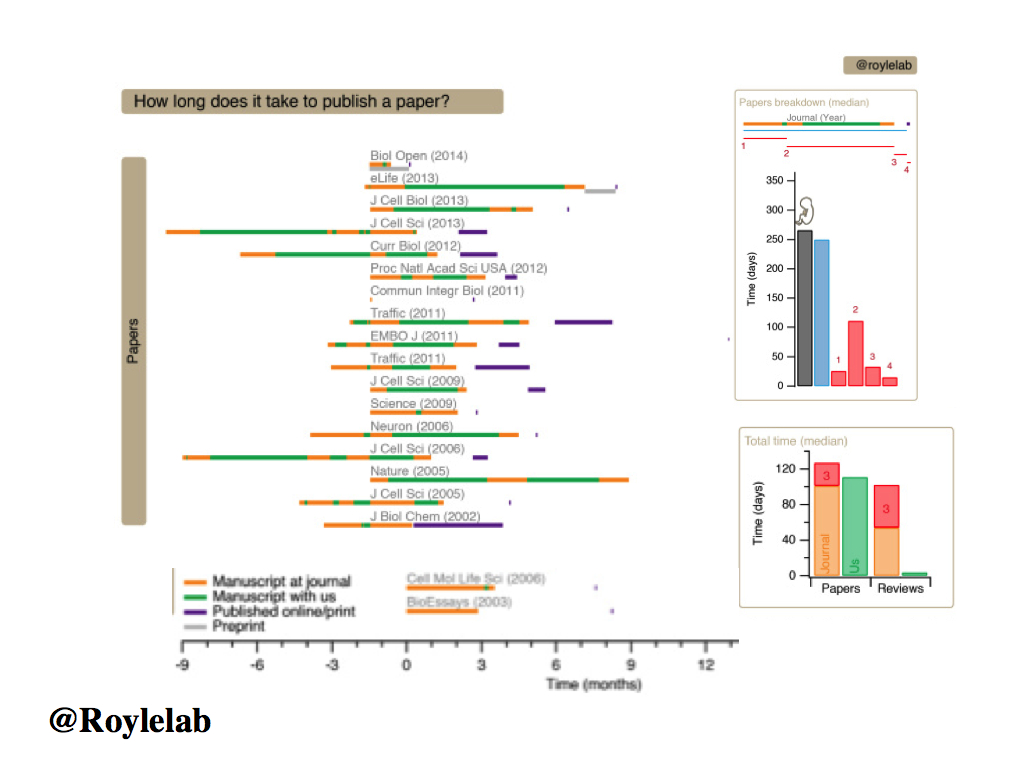 Many of us complain about the influence that editors have on the fate of the papers that we submit to them for publication. However, if you stop and think about the brief historical perspective I have given, you will appreciate that the relationship now is the same that it was at the end of the XIX century: editors decide what is being published. So, what is the difference? A number of things. The first one is that where the editor needed to find papers, nowadays they want to get rid of papers. The other one is that, in the journals that we could call ‘general interest’ where the editors were enlightened individuals with interest and knowledge, today we have basically a whole bunch of poorly trained scientists acting with a lot of power in their hands. The editor scientist has moved to more ‘specialists journalsâ€. Today, more than ever, the generalist journals are not means to tell science to the people but represent a career asset, a ticket to a job and fame. But the other ingredient of the equation hat has changed is that where the editor (always in what I want to call the generalist genre) was an informed person making sure that the science got to the people, today is someone with the limitations derived from lack of experience and the size of the field, using more or less consciously a power they have. If you don’t believe me, read this post that will tell you how your science is not enough because it needs the editor to help you shape. This is certainly the view of Boyana Konforti (Cell Reports at the time of writing https://www.elsevier.com/connect/10-things-you-need-to-know-about-the-publishing-process) who states clearly that a paper is a collaboration between the scientist and the editor who, believe it or not, will help you tell and see a story. As she tells you: keep it simple! Sell a story! …….how low can we get? Are we writing for the editors? Is the scientific level of the editors what we should aspire to imitate? I guess what this is telling you is that if you want to publish your science, take it to ‘specialists journals’ run by scientists but if you want THE product that will give you a job, take it to them. This is where things begin to go pear shaped, where science departs from its original aim and where we have a disconnect between science and the journals. Particularly as I want to emphasize that those journals were not born to be the arbiters of science but to tell science to the people.
Many of us complain about the influence that editors have on the fate of the papers that we submit to them for publication. However, if you stop and think about the brief historical perspective I have given, you will appreciate that the relationship now is the same that it was at the end of the XIX century: editors decide what is being published. So, what is the difference? A number of things. The first one is that where the editor needed to find papers, nowadays they want to get rid of papers. The other one is that, in the journals that we could call ‘general interest’ where the editors were enlightened individuals with interest and knowledge, today we have basically a whole bunch of poorly trained scientists acting with a lot of power in their hands. The editor scientist has moved to more ‘specialists journalsâ€. Today, more than ever, the generalist journals are not means to tell science to the people but represent a career asset, a ticket to a job and fame. But the other ingredient of the equation hat has changed is that where the editor (always in what I want to call the generalist genre) was an informed person making sure that the science got to the people, today is someone with the limitations derived from lack of experience and the size of the field, using more or less consciously a power they have. If you don’t believe me, read this post that will tell you how your science is not enough because it needs the editor to help you shape. This is certainly the view of Boyana Konforti (Cell Reports at the time of writing https://www.elsevier.com/connect/10-things-you-need-to-know-about-the-publishing-process) who states clearly that a paper is a collaboration between the scientist and the editor who, believe it or not, will help you tell and see a story. As she tells you: keep it simple! Sell a story! …….how low can we get? Are we writing for the editors? Is the scientific level of the editors what we should aspire to imitate? I guess what this is telling you is that if you want to publish your science, take it to ‘specialists journals’ run by scientists but if you want THE product that will give you a job, take it to them. This is where things begin to go pear shaped, where science departs from its original aim and where we have a disconnect between science and the journals. Particularly as I want to emphasize that those journals were not born to be the arbiters of science but to tell science to the people.
A recent case highlights everything that is wrong and dangerous about the situation and how the relationship between journals and scientists is sailing dangerously close to a storm.
STAP, a case in point (the perfect storm)
In January 2014 the journal Nature reported a remarkable finding. Somatic cells subject to a simple treatment (addition of lemon juice, as a friend of mine said), which involved stressing them in controlled conditions, could be reprogrammed to an embryonic state. This, the claim went, represented a huge step forward in the ability to produce embryonic stem cells as this would be natural and not involve the genetic manipulations associated with the Yamanaka cocktail. Furthermore, whereas the iPS cells are pluripotent, STAP (Stress Triggered Activation of Pluripotency) were totipotent, as they were able to give rise to extraembryonic tissues in addition to embryonic ones. This was a remarkable finding and because of this there was not only excitement but also suspicion. The simplicity of the experiment and the wide availability of cell lines with appropriate markers led to a widespread interest in doing the experiment –we did think of including it in our undergraduate project repertoire-. The papers were published by Nature and they had important and tested names most notably Y Sasai, H Niwa and T. Wakayama amidst the authors. So, what could go wrong? The first author Obokata became a celebrity and Y. Sasai, corresponding author in the main paper, was only too happy with the outcome. Maybe it was all too good to be true.
We live in the era of social media which has empowered people to speak. Paul Knoepfler, a stem cell biologist in California (USA) runs a blog on stem cells (https://www.ipscell.com/) and from the beginning expressed some scepticism on this finding. He set up a crowdsourced section in his blog where he proposed to report on attempts to reproduce STAP. At the same time he ran a periodic poll on whether people believed in the finding. In February, hope was high and the yeses outnumbered the noes. Slowly, the site was filled with failures to reproduce the finding. What is more, people in websites started to report issues of figure manipulation and text plagiarism which began to raise suspicions on the work and all of a sudden the limelight was on the first author. The web is full of what followed (see sources below) but by the end of May things were not looking good and by the beginning of July the papers were retracted because it became clear that the experiments were fraudulent. The big names put the blame on Obokata, who by now was under a huge amount of pressure (and has been ever since) and Nature claimed innocence. There was one most serious consequence of what happened here. The CDB, the host institution of the researchers, became under close scrutiny and in a surprising development, RIKEN the funding body, recommended its closure. The ball is still in the air but one hopes that the actions of individuals are not taken against an institution which plays an important role in modern developmental and stem cell biology.
The STAP case represents a collusion of interests, jobs, grants and limelight. The details and ramifications of this affair are too complex to dissect here, and I am sure that there will be books and analysis on the matter. Happy to answer questions at the end. There are nonetheless elements that are worth emphasizing. What could have happened here? I am not the only one in thinking that somebody, Obokata perhaps, did see something like STAP at some point. We all have seen black swans in the lab at some point; the problem is that they don’t breed, so we move on. In fact TH Morgan in his book on the Genetics of Drosophila has a section on ‘non heritable characters’ to quote an example. The magnitude of the possibility that harbours the finding and pressures from different sources that ensue then lead to the slippery slope. A group of people see glitter where there is dust and then you get the package: no questioning from above (if you understand Japanese you might be interested in this, and if not and you are interested, get someone to translate this for you: https://headlines.yahoo.co.jp/hl?a=20140416-00000024-wordleaf-sctch), the seal of approval of the big names, the seal of the big journal and, somewhere, the hope that somebody will see it again. I do not think that someone would expose themselves in the manner that Obokata did, unless there is some truth, and I suspect that she thought that somebody would see another black swan. How much Sasai, as corresponding author, knew is difficult to say but the fact remains that he signed as corresponding author. Much to ponder here on the structure and responsibilities in modern science. Ultimately the problem is that what was driving this affair was not science but the limelight. On the other hand, what brought this out was not just the scientists, it was the scientific community through the open discussion provided by social media, which has empowered people. And what responsibility with Nature? More than they are prepared to admit. They claim that the peer review process could not have picked up the problems (www.nature.com/news/stap-retracted-1.15488), but it was the science community which picked it up!. Furthermore, the manuscript had been rejected from Cell and Science. Furthermore, a quick standard run of the manuscript through image manipulation software run by EMBO J picked up problems almost instantly (https://onlinelibrary.wiley.com/doi/10.15252/embj.201489076/full). So, what one can conclude is that Nature’s peer review process, not THE peer review process, failed to detect the problems. As Nature refuses to provide details of the review process, we do not know what happened, but the refusal to be open (perhaps reasonable but not justifiable) does not help.
Now, this is not the first time that something like this happens in one of the main journals. Nature, Science and Cell have had their share of high profile retractions. In a remarkable one a few years ago, JH Schoen retracted 8 papers from Science and 7 from Nature (not to mention several from prestigious physics journals). This highlights the problem because as has been stated, the issue here is the scale which highlights the depth of the problem. How come that the journals do not take any impact? Have you heard of any editors resigning out of any of these affairs? Have you heard of the journals closing, receiving public scrutiny? Imagine that they were companies trading in the Stock Market. If something like STAP happens, and happens repeatedly, what happens to the shares? What happens to the company? And yet, in these journals nothing happens.
Where are we?
In the end, what we have is a situation in which these generalist journals have a different aim from their original one. Where they (though I should point out that Cell does not fit this mould) meant to be a vehicle to get science to the general public, they have become a, THE, measure of success. In fact, in China this is made clear in terms of outright payment proportional to where you publish (https://scholarlykitchen.sspnet.org/2011/04/07/paying-for-impact-does-the-chinese-model-make-sense/ ). But do not be surpised, as pointed out earlier, in Europe and the US we offer something much better: a pension!
We, a collective we, have used Nature, Science and Cell to create a rock star culture which has eroded into the base of what we do. The main reason for this, I believe, is the fact that the structure of the system we are using is, basically, the same as it was in the XIX century to which we have just added layers without restructuring it. An overloaded camel at the end of a long trip. This, together with a change of emphasis and aims, leads to  a machine that churns out papers with a lot of power in its hands and under the control of ill-prepared professionals which, basically, follow orders. NB I am not discussing here scientists led journals, some of which have a few of the same problems but which certainly do not have the ‘impact’ that lies at the heart of the malaise.
Fortunately we are waking up and solutions are on the way. In the final part of this discussion I want, briefly, to address some of them.
Additional Sources
Burnham, J. (1990) The evolution of editorial peer review. JAMA 263, 1323-1329.
Cyranoski, D.(2014) Cell induced stress Nature 511, 140143.
Kronick, DA (1990) Peer review in 18th century scientific journalism. JAMA 263, 1321-1322.
Nielsen, M. Three myths about scientific peer review (https://michaelnielsen.org/blog/three-myths-about-scientific-peer-review/)
Normile, D. and Vogel, G. (2014) STAP cells succumb to pressure Science 344, 1215-1216.
Spier, R. (2002) The history of peer review process Trends in Biotech.8, 357-358.
On the Schoen affair, take as a start: https://en.wikipedia.org/wiki/Sch%C3%B6n_scandal but there is much more on the web.
Very readable, interesting and informative history of Nature magazine: https://www.nature.com/nature/history/timeline_1860s.html
On Elsevier, with its long and distinguished history: https://www.elsevier.com/__data/assets/pdf_file/0014/102632/historyofelsevier.pdf


